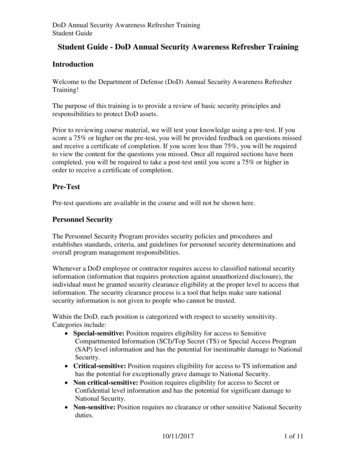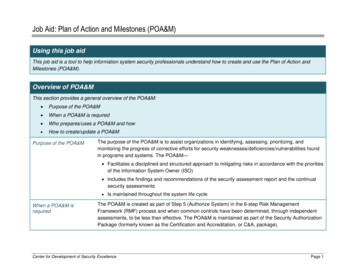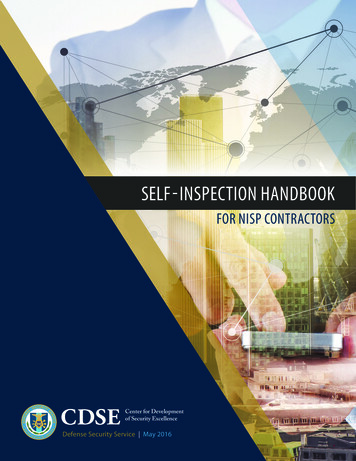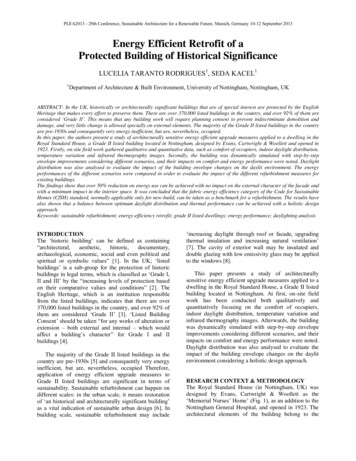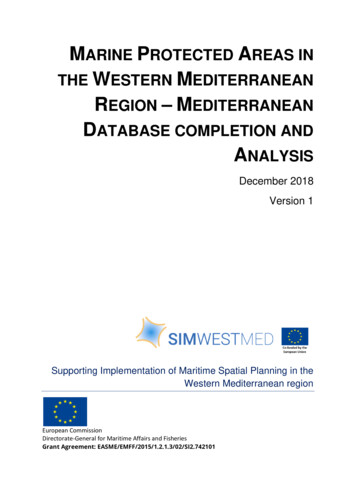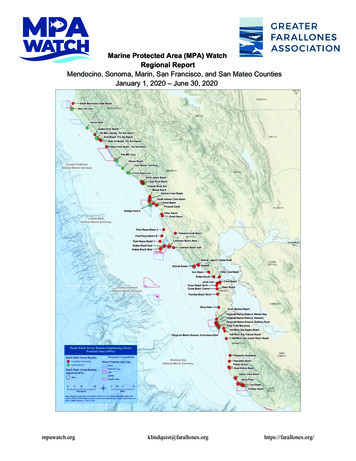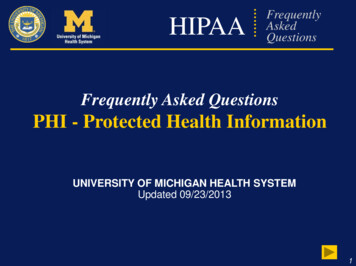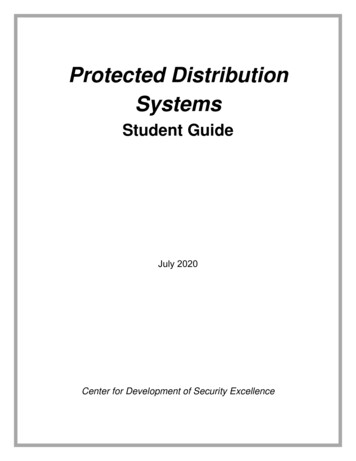
Transcription
Protected DistributionSystemsStudent GuideJuly 2020Center for Development of Security Excellence
Protected Distribution SystemsStudent GuideLesson 1: Course IntroductionIntroductionCourse OverviewWelcome to the Protected Distribution Systems course. Protected Distribution Systems(PDSs) are one solution to safeguarding classified information. But who is responsible for aPDS, and what are the requirements for approving, installing, and inspecting a PDS?This course addresses the PDS requirements for all DoD Components. After the conclusionof the course, an optional lesson is available that covers specific PDS implementingrequirements for industry under the National Industrial Security Program (NISP).Course ObjectivesHere are the course objectives. Take a moment to review them. Describe the purpose of a Protected Distribution System (PDS), its categories, andcarrier types Describe how data type, threat environment, and access area affect PDS categoryselection Identify the roles and responsibilities for installation, approval, operation, andinspection of a PDS Identify standards and procedures for PDS installation Describe requirements to perform PDS inspectionsJuly 2020Center for Development of Security Excellence1-1
Protected Distribution SystemsStudent GuideLesson 2: Overview of the PDSIntroductionObjectivesThis lesson introduces: The Protected Distribution System (PDS) Categories and carrier types What affects PDS category selection The roles and responsibilities for the PDS installation, approval, operation andinspectionHere are the lesson objectives. Take a moment to review them. Describe the purpose of a Protected Distribution System (PDS), its categories, andcarrier types Describe how data type, threat environment, and access area affect PDS categoryselection Identify the roles of the Authorizing Official (AO) and the PDS owner for the PDSPolicy GuidanceThe Committee on National Security Systems Instruction (CNSSI) No. 7003 providesguidance and standards for Protected Distribution Systems. The guidance was issued underthe authority of National Security Directive 42: National Policy for the Security of NationalSecurity Telecommunications and Information Systems. It supersedes the National SecurityTelecommunications and Information Systems Security Instruction (NSTISSI) 7003,Protected Distribution Systems, dated 13 December 1996.You may access the CNSSI No. 7003 via the Course Resources page.Purpose and CategoriesPurposeA PDS is used to protect unencrypted national security information (NSI) that is transmittedon wire line or optical fiber. Because the NSI is unencrypted, the PDS must providesafeguards to deter exploitation. The emphasis is on intrusion detection rather thanprevention of penetration.July 2020Center for Development of Security Excellence2-1
Protected Distribution SystemsStudent GuideA PDS is intended primarily for use in low and medium threat locations, and is notrecommended for use in high or critical threat locations. It is also NOT PERMITTED inuncontrolled access areas. For those areas, you must use an encryption solution instead.CategoriesThere are two categories of PDS.Category 1 provides a reduced level of security and is used in more secure environments.There is a single type of carrier for a Category 1 PDS. It is called a simple carrier, and it isconstructed of metal or polyvinyl chloride pipe. This type of construction can be installed atreduced costs.A Category 2 PDS provides more significant physical levels of security protection and hasfive types of carriers: A hardened carrier is constructed of a ferrous metal, such as ferrous electricalmetallic tubing, ferrous pipe conduit, or ferrous rigid sheet metal ducting. It isnormally used between controlled access areas (CAAs) in the same building. A buried carrier is used between CAAs located in different buildings. A suspended carrier can be used for short runs when it is not practical to bury thecarrier between buildings. An alarmed carrier is used when it is not practical to perform required dailyinspections. A continuously viewed carrier can be used within an area that is already underconstant surveillance for physical security reasons.Selecting a PDS CategoryThe guidance for selecting a Category 1 or Category 2 PDS is based on three factors.The first is the classification or type of data (Confidential, Secret, Top Secret, and SensitiveCompartmented Information) that is being handled.The second is the area through which the PDS is installed, whether low threat or mediumthreat. A PDS is NOT recommended for use in high or critical threat locations. Use of a PDSin high and critical threat locations must be approved by the AO prior to design. Note that itis the Certified Tempest Technical Authority who defines your threat environment.The third factor is the type of access area in which the PDS is installed, whether in a CAAwith the highest restriction of unauthorized access or in a limited access area (LAA) whereexploitation is considered unlikely. Recall that PDS usage is not permitted for anuncontrolled access area (UAA). Data passing through UAAs must be encrypted.July 2020Center for Development of Security Excellence2-2
Protected Distribution SystemsStudent GuideAccess AreasCNSSI No. 7003 specifically defines controlled access area, limited access area, anduncontrolled access area.TermDefinitionControlled AccessArea (CAA)The complete building or facility area under direct physical control withinwhich unauthorized persons are denied unrestricted access and areeither escorted by authorized persons or are under continuous physicalor electronic surveillance.Limited Access Area(LAA)The space surrounding a PDS within which PDS exploitation is notconsidered likely or where legal authority to identify and remove apotential exploitation exists.Uncontrolled AccessArea (UAA)The area external or internal to a facility over which no personnel accesscontrols are or can be exercised or any area not meeting the definition ofControlled Access Area (CAA) or LAA.Table 1Table 1 from CNSSI No. 7003 defines the category of PDS required for low threatenvironments. For example, when the access area is controlled, a Category 1 PDS issufficient. However, when the access area is limited, a Category 2 PDS is required if thedata is Secret or higher.Table 1. Category of PDS required for Low Threat EnvironmentsType of Access AreaType of dConfidential1Secret21Top Secret211SensitiveCompartmentedInformation211Top Secret,Controlled1Table 2Table 2 defines the category of PDS required for medium threat environments.Note that, with the increase in threat environment to medium, a Category 2 PDS is requiredfor the Confidential Controlled access area when Top Secret or Sensitive CompartmentedInformation is handled.July 2020Center for Development of Security Excellence2-3
Protected Distribution SystemsStudent GuideTable 2. Category of PDS required for Medium Threat EnvironmentsType of Access AreaType of dConfidential1Secret21Top Secret221SensitiveCompartmentedInformation221Top Secret,Controlled1Responsibilities and the Approval ProcessResponsibilitiesThe basic responsibilities for the PDS are shared by the Authorizing Official (AO) and thePDS Owner.The AO is responsible for PDS approval, certification, and recertification. The AO also mustapprove reactivation of a PDS. Note that the PDS has its own approval process that isseparate from the Assessment and Authorization (A&A) for systems and networks.The PDS owner is responsible for the installation and maintenance of the PDS.Next, look at how these responsibilities play out in the PDS approval process.The Approval ProcessAll PDS requests must go through an approval process.The PDS owner originates the request. Counterintelligence (CI) personnel are responsiblefor conducting a CI risk assessment to assess the potential risk of exploitation. The PDSapproval request describes the specifics of the PDS, including unique facts regarding thefacility, installation details, inspection methods, and schedule. The PDS owner must developa Standard Operating Procedure (SOP) to ensure proper installation, maintenance,operation, and inspection of the PDS and submit the SOP as part of the approvaldocumentation.The request undergoes technical review and must be approved by the AO BEFORE theprocurement of materials.The PDS owner is then responsible for installing the PDS. Note that during constructiontemporary configurations that are used to test the operation of data lines or the network donot require a technical review.July 2020Center for Development of Security Excellence2-4
Protected Distribution SystemsStudent GuideWhen installation is complete, the AO must ensure the PDS is inspected and approved priorto initial operation.The PDS owner is responsible for the operation, maintenance, and inspection of the PDS.CI Risk AssessmentCNSSI No. 7003 lists these factors to consider at a minimum in the CI risk assessment.NOTE: The information in the box below will not be on the test but is included here as additionalinformation that may provide useful background and insight.a. Foreign or domestic location.b. Use of U.S. citizens for 24/7 access control.c.Use of U.S. procured, installed, and monitored intrusion detection devices.d. Presence of uncleared personnel or foreign nationals in, on, or nearby the controlledfacility/compound.e. Existence of any co-located, unaffiliated tenants in the facility.f.Proximity of the PDS to other infrastructure requiring maintenance.g. Any use or dependency on contracted security for intrusion detection/reporting/response.h. Stand-off distance from the PDS to the perimeter of the controlled area.i.Proximity of the PDS to uncontrolled buildings and structures beyond the perimeter andthe nationality of tenants of those buildings.j.Known human intelligence (HUMINT) and technical threat (capabilities, intentions, andactivities) of the host nation.k.Known history of foreign host and foreign intelligence security services (FISS)capabilities and activities to exploit PDS, fiber optics, and communications closets.Temporary ConfigurationCNSSI No. 7003 specifically defines Temporary Configuration.Temporary configurations are those which are in place for less than 30 calendar days and areconfined within USG installations in areas that are not accessible to the general public, and donot process higher than Secret collateral information.Modification, Deactivation, and ReactivationNow consider the responsibilities for modifying, deactivating, or reactivating an approvedPDS.Before a PDS can be modified, the AO must first approve the modification. After the PDS ismodified, it must be recertified by the AO. If a PDS needs to be deactivated, the PDS ownermust notify the AO within 30 days of the deactivation. Before the PDS can be reactivated,the AO must approve the reactivation.July 2020Center for Development of Security Excellence2-5
Protected Distribution SystemsStudent GuideNote that, both modification and reactivation may require additional review onsite.Review ActivitiesReview Activity 1What is the purpose and use of a Protected Distribution System (PDS)?Select all that apply. Check your answer in the Answer Key at the end of this Student Guide. It is used to protect unencrypted National Security Information (NSI). The emphasis is on prevention of penetration. It is intended for use in high or critical threat locations. It is not permitted in uncontrolled access areas.Review Activity 2Which category of Protected Distribution System (PDS) is appropriate for the followingsituations?For each situation, select the best response. Check your answer in the Answer Key at theend of this Student Guide.The carrier must pass through an uncontrolled access area. Category 1 Category 2 NeitherA buried PDS connects controlled access areas. Category 1 Category 2 NeitherA Top Secret PDS in a confidential controlled access area in a low threat environment Category 1 Category 2 NeitherJuly 2020Center for Development of Security Excellence2-6
Protected Distribution SystemsStudent GuideA Top Secret PDS in a confidential controlled access area in a medium threat environment Category 1 Category 2 NeitherReview Activity 3Who is responsible for these activities?For each activity, select the best response. Check your answer in the Answer Key at the endof this Student Guide.Ensure PDS is inspected and certified prior to initial operation PDS Owner Authorizing Official (AO)Operation, maintenance, and inspection of PDS PDS Owner Authorizing Official (AO)Installation of PDS PDS Owner Authorizing Official (AO)Approving reactivation of a PDS PDS Owner Authorizing Official (AO)July 2020Center for Development of Security Excellence2-7
Protected Distribution SystemsStudent GuideLesson 3: Installation GuidanceIntroductionWelcomeProper Protected Distribution System (PDS) installation is important to ensure the security ofunencrypted National Security Information (NSI).This lesson introduces General installation requirements Installation guidance for Category 1 and Category 2 carriers Installation requirements for pull boxes and other PDS connections The requirements for marking a PDSSections VIII, IX, and X of CNSSI No. 7003 contain detailed installation guidance. You mayaccess the CNSSI No. 7003 via the Course Resources page.ObjectivesHere are the lesson objectives. Take a moment to review them. Describe the installation requirements for Category 1 and Category 2 carriers Identify installation requirements for pull boxes and other Protected DistributionSystem (PDS) connections Describe the requirements for marking a PDSGeneral Installation GuidanceOrigination and TerminationThere are specific requirements regarding the origination and termination points for a PDS.A PDS must originate in a controlled access area (CAA) th
Describe the purpose of a Protected Distribution System (PDS), its categories, and carrier types Describe how data type, threat environment, and access area affect PDS category selection Identify the roles of the Authorizing Official (AO) and the PDS owner for the PDS. Policy GuidanceFile Size: 229KBPage Count: 46
